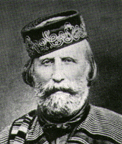Garibaldi Unites Sicily with Savoy
Paradoxically,
the uprisings also raised the popular image of the Kingdom of Savoy,
which proved itself to be a staunch and remarkably faithful ally in
the ultimately unsuccessful struggle to eject Austria from its occupation
of northern Italy. In 1859 Savoy, in an alliance with France, renewed
the conflict and ousted Austria from the Piedmont [Turin] area of
northern Italy. Popular uprisings against Austria's puppet rulers
in the Tuscany and Romagna regions followed quickly, and those areas
petitioned to become part of the expanded Savoy kingdom. In the Kingdom
of Two Sicilies, comprising Sicily and the southern portion of the
Italian peninsula, the death of King Ferdinand in May 1859 brought
his son Francis II to the throne. King Francis II failed to perceive
the dire implications that the changes in the north held for his own
kingdom--or failed to respond adequately if he did perceive them. Thus, the
Savoy kingdom was extended to encompass all of the Italian peninsula
except the area around Rome, which was ruled by the Pope, and the
Veneto, which remained in Austrian hands. By 1866 those areas too
had been consolidated, and the modern Kingdom of Italy had been created
with its capital in Rome.
![[Location map to be added here]](futuremap.gif) The
vision of a united Italy haunted many kings and princes through the
centuries that followed the breakup of the Roman Empire. Though nothing
had come of all their dreams, the vision still lingered in the minds
of Italians in the mid-19th century. The brief republican uprisings
in 1848 brought new life to the idea as cities across the Italian
peninsula found themselves cooperating with each other in their popular
struggles.
The
vision of a united Italy haunted many kings and princes through the
centuries that followed the breakup of the Roman Empire. Though nothing
had come of all their dreams, the vision still lingered in the minds
of Italians in the mid-19th century. The brief republican uprisings
in 1848 brought new life to the idea as cities across the Italian
peninsula found themselves cooperating with each other in their popular
struggles.  On
May 11 the Savoy military hero Giuseppe Garibaldi landed on the west
coast of Sicily with a force of just 1,000 men. With some help from
Sicilian revolutionaries, Garibaldi's force rolled quickly across
the island, pausing only for major victories at Calatafimi and Milazzo.
In early August he launched his forces across the Straits of Messina
and marched rapidly to Naples, which fell on September 7--ending the
Kingdom of Two Sicilies.
On
May 11 the Savoy military hero Giuseppe Garibaldi landed on the west
coast of Sicily with a force of just 1,000 men. With some help from
Sicilian revolutionaries, Garibaldi's force rolled quickly across
the island, pausing only for major victories at Calatafimi and Milazzo.
In early August he launched his forces across the Straits of Messina
and marched rapidly to Naples, which fell on September 7--ending the
Kingdom of Two Sicilies.
©
2000 C. I. Gable